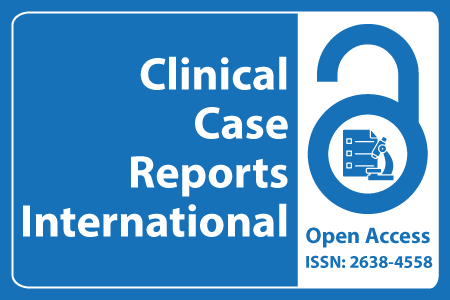
Journal Basic Info
- Impact Factor: 0.285**
- H-Index: 6
- ISSN: 2638-4558
- DOI: 10.25107/2638-4558
Major Scope
- Family Medicine and Public Health
- Vascular Medicine
- Cancer Clinic
- Sleep Disorders & Sleep Studies
- Endoscopy
- Internal Medicine
- Food Science
- Ophthalmology
Abstract
Citation: Clin Case Rep Int. 2022;6(1):1369.DOI: 10.25107/2638-4558.1369
MR Imaging Spectrum in Acute Invasive Fungal Rhinosinusitis (AIFRS) Following COVID-19 Infection Treated with Steroids
Kanika Sekhri Sethi, Subham Choudhary, Anmol Uberoi, Prem Kumar Ganesan, Sugandha Dhawan, WVBS Ramalingam and Neha Sood
Department of Radiodiagnosis, BL Kapur Memorial Hospital, India
Department of Radiodiagnosis, St. Stephen’s Hospital, India
Department of ENT, Dr. B. L. Kapur Memorial Hospital, India
*Correspondance to: Subham Choudhary
PDF Full Text Short Communication | Open Access
Abstract:
Introduction: Acute Invasive Fungal Rhinosinusitis (AIFRS) is a critical and life-threatening, very rapidly progressing infection caused by fungi. COVID-19 disease may be associated with fungal coinfections, especially post-steroid treatment, and severely impaired glycemic control. MRI plays a vital role in the early diagnosis and severity of the infection. The purpose of this study is to highlight the various spectrums of the imaging findings. Methods: This is a prospective study done during and following SARS-Coronavirus 2 COVID-19 infection in India from April 2021 to February 2022. Descriptive statistics was the statistical tool used in this study. Results: MRI of 32 patients showed mainly involvement of the paranasal sinuses (100% of patients), nasal cavity (56% of the patients), orbits (47% of the patients), premaxillary, retroantral & pterygopalatine fossa (56% of the patients), skull base (34 % of the patients) and intracranial spread (25% of the patients). A heterogeneous hypointense signal on T2WI and peripheral heterogeneous enhancement with central non-enhancing areas in 15 patients (47%), known as a black-turbinate sign. Among intracranial spread, six patients developed cavernous sinus thrombosis (19% of the patients ), and four developed vascular infarcts (12.5% of the patients). The perineural spread was seen in a single patient (3%). Results: MRI of 32 patients showed mainly involvement of the paranasal sinuses (100% of patients), nasal cavity (56% of the patients), orbits (47% of the patients), premaxillary, retroantral & pterygopalatine fossa (56% of the patients), skull base (34 % of the patients) and intracranial spread (25% of the patients). A heterogeneous hypointense signal on T2WI and peripheral heterogeneous enhancement with central non-enhancing areas in 15 patients (47%), known as a black-turbinate sign. Among intracranial spread, six patients developed cavernous sinus thrombosis (19% of the patients), and four developed vascular infarcts (12.5% of the patients). The perineural spread was seen in a single patient (3%). Conclusion: Contrast-enhanced MRI shows various spectrums of findings in AIFRS, which hence plays a very important role in further assessing the extent of involvement, guiding for treatment, and predicting possible complications.
Keywords:
Acute Invasive Fungal Rhinosinusitis (AIFRS); COVID-19; Hyperglycemia
Cite the Article:
Sethi KS, Choudhary S, Uberoi A, Dhawan S, Ganesan PK, Ramalingam WVBS, et al. MR Imaging Spectrum in Acute Invasive Fungal Rhinosinusitis (AIFRS) Following COVID-19 Infection Treated with Steroids. Clin Case Rep Int. 2022; 6:1369.













